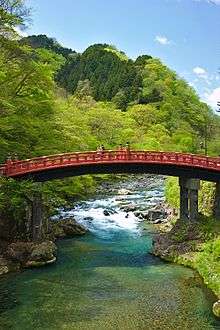Nikkō, Tochigi
| Nikkō 日光市 | |||
|---|---|---|---|
| City | |||
|
Nikko City Hall | |||
| |||
 Location of Nikkō in Tochigi Prefecture | |||
 Nikkō
| |||
| Coordinates: 36°43′11.4″N 139°41′53.4″E / 36.719833°N 139.698167°ECoordinates: 36°43′11.4″N 139°41′53.4″E / 36.719833°N 139.698167°E | |||
| Country | Japan | ||
| Region | Kantō | ||
| Prefecture | Tochigi Prefecture | ||
| Area | |||
| • Total | 1,449.83 km2 (559.78 sq mi) | ||
| Population (May 2015) | |||
| • Total | 84,197 | ||
| • Density | 58.1/km2 (150/sq mi) | ||
| Time zone | Japan Standard Time (UTC+9) | ||
| - Tree | Betula platyphylla, Autumn leaf color | ||
| - Flower | Rhododendron, Hemerocallidoideae | ||
| - Bird | Cettia diphone, Alcedo atthis | ||
| Phone number | 0288-22-1111 | ||
| Address | 1 Imaichi Honchō, Nikkō-shi, Tochigi-ken 321-1292 | ||
| Website | Official website | ||
Nikkō (日光市 Nikkō-shi) is a city located in Tochigi Prefecture, in the northern Kantō region of Japan. As of May 2015, the city had an estimated population of 84,197 and a population density of 58.1 persons per km². Its total area was 1,449.83 km². it is a popular destination for Japanese and international tourists. Attractions include the mausoleum of shogun Tokugawa Ieyasu (Nikkō Tōshō-gū) and that of his grandson Iemitsu (Iemitsu-byō Taiyū-in), and the Futarasan Shrine, which dates to the year 767. There are also many famous hot springs (onsen) in the area. Elevations range from 200 to 2,000 m.[1] The Japanese saying "Never say 'kekkō' until you've seen Nikkō"—kekkō meaning beautiful, magnificent or "I am satisfied"—is a reflection of the beauty and sites in Nikkō.[2][3]
Geography

Nikkō covers a large area (1,449.83 km²) of rural northwestern Tochigi approximately 140 km north of Tokyo and 35 km west of Utsunomiya, the capital of Tochigi Prefecture. It is the third-largest city (by area) in Japan, behind Takayama and Hamamatsu.
Both the Watarase River and the Kinugawa River pass through the city. Lake Chūzenji and the Kegon Falls lie in Nikkō, as does the Nikko Botanical Garden. The city's many mountains and waterfalls have made it an important source of hydroelectric power. The area has also been used for mining copper, aluminum and concrete.
The weather in Nikkō is fairly similar to that of the northern island of Hokkaidō even though Nikkō is much closer to Tokyo than Hokkaidō. The elevation of Nikkō plays an important role in this fact. It will usually get cooler as one ascends the mountain. The average temperature of Nikkō is around 7 °C (44 °F) [4] with the warmest months reaching only about 22 °C (72 °F)[5] and the coldest reaching down to about -8 °C (17 °F).[6]
Surrounding municipalities
Climate
Nikkō experiences a humid continental climate (Köppen climate classification Dfb) with cold, snowy winters and predominantly mild, very wet summers. Nikkō is much cooler than nearby parts of Honshu because it is situated at an altitude of 1298m above sea level.
| Climate data for Nikkō, Tochigi | |||||||||||||
|---|---|---|---|---|---|---|---|---|---|---|---|---|---|
| Month | Jan | Feb | Mar | Apr | May | Jun | Jul | Aug | Sep | Oct | Nov | Dec | Year |
| Average high °C (°F) | −0.6 (30.9) |
−0.5 (31.1) |
2.8 (37) |
9.8 (49.6) |
14.7 (58.5) |
17.3 (63.1) |
21.1 (70) |
22.4 (72.3) |
18.1 (64.6) |
12.7 (54.9) |
8.0 (46.4) |
2.7 (36.9) |
10.71 (51.28) |
| Daily mean °C (°F) | −4.4 (24.1) |
−4.3 (24.3) |
−1.4 (29.5) |
4.9 (40.8) |
9.8 (49.6) |
13.4 (56.1) |
17.4 (63.3) |
18.5 (65.3) |
14.5 (58.1) |
8.5 (47.3) |
3.7 (38.7) |
−1.3 (29.7) |
6.61 (43.9) |
| Average low °C (°F) | −8.4 (16.9) |
−8.2 (17.2) |
−5.7 (21.7) |
−0.1 (31.8) |
4.7 (40.5) |
9.7 (49.5) |
14.0 (57.2) |
15.1 (59.2) |
11.2 (52.2) |
4.5 (40.1) |
−0.4 (31.3) |
−5.2 (22.6) |
2.6 (36.68) |
| Average precipitation mm (inches) | 47.9 (1.886) |
68.2 (2.685) |
94.4 (3.717) |
151.5 (5.965) |
167.1 (6.579) |
245.3 (9.657) |
249.8 (9.835) |
382.2 (15.047) |
336.6 (13.252) |
184.3 (7.256) |
101.9 (4.012) |
45.4 (1.787) |
1,824.8 (71.843) |
| Average snowfall cm (inches) | 44 (17.3) |
57 (22.4) |
62 (24.4) |
15 (5.9) |
0 (0) |
0 (0) |
0 (0) |
0 (0) |
0 (0) |
0 (0) |
8 (3.1) |
29 (11.4) |
215 (84.5) |
| Average relative humidity (%) | 65 | 66 | 67 | 71 | 74 | 85 | 87 | 86 | 86 | 79 | 71 | 66 | 75.3 |
| Mean monthly sunshine hours | 178.5 | 162.1 | 194.1 | 175.9 | 184.1 | 109.9 | 114.5 | 136.7 | 98.6 | 134.1 | 155.0 | 174.7 | 1,818.2 |
| Source: NOAA (1961-1990) [7] | |||||||||||||
History

Shōdō Shōnin (勝道上人) established the temple of Rinnō-ji in 766, followed by the temple of Chūzen-ji in 784. The village of Nikkō developed around these temples. The shrine of Nikkō Tōshō-gū was completed in 1617 and became a major draw of visitors to the area during the Edo period. It is known as the burial place of the famous Japanese shogun Tokugawa Ieyasu. A number of new roads were built during this time to provide easier access to Nikkō from surrounding regions. Nikkō Tōshō-gū, Futarasan Shrine, and Rinnō-ji now form the UNESCO World Heritage Site Shrines and Temples of Nikkō.
During the Meiji period Nikkō developed as a mountain resort, and became particularly popular among foreign visitors to Japan. The Japanese National Railways began service to Nikkō in 1890 with the Nikkō Line, followed by Tobu Railway in 1929 with its Nikkō Line.
Nikkō was incorporated as a town in 1889, (part of Kamitsuga District). It was upgraded to city status in 1954 after merging with the neighboring village of Okorogawa.
On March 20, 2006, Nikkō absorbed the old city of Imaichi, the town of Ashio (from Kamitsuga District), the town of Fujihara, and the village of Kuriyama (both from Shioya District), to create what is officially the new and expanded city of Nikkō. The new city hall is located at the former Imaichi City Hall; the former Nikkō City Hall is now known as Nikkō City Hall-Nikkō Satellite Office.
Economy
Nikkō is heavily dependent on tourism to its historical and scenic sites and hot spring resorts. Hydroelectric power production, food processing, and the metals industry remain important components of the economy.
Education
Nikko has 23 primary schools, 15 middle schools and three high schools.
Transportation

Railway
Highway
- Tōhoku Expressway – Yaita IC, Yaita-Kita PA
- Japan National Route 4
- Japan National Route 461
Local attractions

(from left) Hear no evil, speak no evil, see no evil

- Cedar Avenue of Nikko
- Nikko Botanical Garden
- Shrines and Temples of Nikkō (Nikkō Tōshō-gū, Futarasan Shrine, and Rinnō-ji)
- Tōshō-gū
- The Three wise monkeys ("See no evil, hear no evil, speak no evil")
- Rinnō-ji
- Futarasan Shrine
- Lake Chūzenji
- Edo Wonderland Nikko Edomura (historical theme park)
- Nikko is well known for its monkeys that walk around the town in the winter looking for food.
- Jizo Bosatsu statues on the Kanman Walk. A little out of the main city, locals often tell visitors to count the statues while walking, and to recount while walking back. The number is often different, fueling a legend amongst locals.
Sports

Nikkō is the home city to the Nikkō Ice Bucks in the Asia League Ice Hockey. Nikkō Kirifuri Ice Arena hosted the Women's Ice Hockey World Championships (Division I) in April 2007.
There is also a speed skating oval.
Sister city relations
-
 Palm Springs, California, United States, sister city since July 30, 1969
Palm Springs, California, United States, sister city since July 30, 1969 -
 Rapid City, South Dakota, United States, sister city since February 7, 1993
Rapid City, South Dakota, United States, sister city since February 7, 1993 -
 Tainan, Taiwan, friendship city since January 16, 2009
Tainan, Taiwan, friendship city since January 16, 2009 -
 Odawara, Kanagawa, since December 19, 1980
Odawara, Kanagawa, since December 19, 1980
Noted people from Nikkō
- Masaru Ibuka – entrepreneur, co-founder of Sony[8]
- Shoma Sato – professional baseball player [9]
- Akio Fukuda – politician [10]
- Tomikazu Fukuda – politician [11]
References
- ↑ "Nikko City/Location, Topography & History of Nikko City". Nikko City. Archived from the original on 2007-05-27. Retrieved 23 April 2008.
- ↑ Lohn, Steve (11 September 1983). "Shrine of the Shogun". New York Times.
- ↑ "Aizu/Nikko Challenging". okatours.com.
- ↑ "NIKKO, 24-hr Average Temperature". worldclimate.com.
- ↑ "NIKKO, Average Maximum Temperature". worldclimate.com.
- ↑ "NIKKO, Average Minimum Temperature". worldclimate.com.
- ↑ "Nikkō Climate Normals 1961-1990". National Oceanic and Atmospheric Administration. Retrieved January 5, 2013.
- ↑ Kirkup, James. "Obituary: Masaru Ibuka," Independent (London). December 22, 1997.
- ↑ Baseball-reference.com
- ↑ Official home page (in Japanese)
- ↑ official home page(in Japanese)
External links
-
 Media related to Nikkō, Tochigi at Wikimedia Commons
Media related to Nikkō, Tochigi at Wikimedia Commons -
 Nikko travel guide from Wikivoyage
Nikko travel guide from Wikivoyage - Nikko Tourist Association (in Japanese)
- Nikko Tourist Association (in English)
- Nikko City official website (in Japanese)
- Shrines and Temples of Nikko (in English)
- Early foreign tourist Isabella Bird's report

